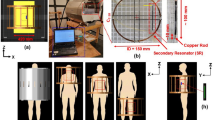Abstract
The electromagnetic field (EMF) may have a direct influence on the functions of human body, for example through the electrostimulation of the nervous system or tissue heating. The spatial distribution and the level of such influence, estimated by induced electric field strength (Ein) or specific energy absorption rate (SAR), are different in body tissues close to a medical implant, compared to the body without an implant during the same exposure. Numerical models of EMF sources (loop antennas) with dimensions typical for magnetotherapeutic applicators and high frequency radiofrequency identification (RFID HF) readers, and the user of a hearing implant (Bonebridge type – HI-BB) were worked out. The values of Ein and SAR were analyzed in the head of an HI-BB user exposed to EMF in the worst case scenario – at the shortest distance of 2 cm from EMF sources (at the side or at the edge in front of them). It was demonstrated that the use of HI-BB significantly increases the level of direct exposure effects caused by EMF – in low frequency EMF (Ein up to 3.4 times higher), and in radiofrequency EMF (SAR (1 g) up to 4.5 times higher). The level of such hazards depends on the dimensions of the EMF source and the location of the head against the source (i.e. the field polarization). It was shown that low and radiofrequency EMF is a direct environmental hazard for the hearing implant users, but the analysis of the individual sensitivity of particular users still required further studies involving more detailed models of implants and users’ bodies, as well studies covering the indirect EMF influence on the electronic circuits of HI-BB, recognized as electromagnetic compatibility (EMC).
Access this chapter
Tax calculation will be finalised at checkout
Purchases are for personal use only
Similar content being viewed by others
References
Med-EL. http://www.medel.com
Zradziński, P., Karpowicz, J., Gryz, K., Leszko, W.: Evaluation of the safety of users of active implantable medical devices (AIMD) in the working environment in terms of exposure to electromagnetic fields – practical approach to the requirements of European Directive 2013/35/EU. Int. J. Occup. Med. Environ. Health 31(6), 795–808 (2018)
Hansson Mild, K., Hocking, B.: Guidance note: risk management of workers with medical electronic devices and metallic implants in electromagnetic fields. Int. J. Occup. Saf. Ergon. (JOSE) 14(2), 217–222 (2008)
International Commission on Non-Ionizing Radiation Protection: Guidelines for Limiting Exposure to Time-Varying Electric and Magnetic Fields (1 Hz–100 kHz). Health Phys. 99(6), 818–836 (2010)
International Commission on Non-Ionizing Radiation Protection: Guidelines for Limiting Exposure to Time-Varying Electric, Magnetic and Electromagnetic Fields (up to 300 GHz). Health Phys. 74(4), 494–522 (1998)
Council of the European Union Recommendation of 12 July 1999 on the limitation of exposure of the general public to electromagnetic fields (0 Hz to 300 GHz), 1999/519/EC, Official Journal of the European Communities, L 199/59
Directive 2013/35/EC of the European Parliament and of the Council of 26 June 2013 on the minimum health and safety requirements regarding the exposure of workers to the risks arising from physical agents (electromagnetic fields) (20th individual Directive within the meaning of Article 16(1) of Directive 89/391/EEC) and repealing Directive 2004/40/EC. Off J Eur Union. 2013;L 179/1
Zradziński, P., Karpowicz, J., Gryz, K., Leszko, W.: Ocena zagrożeń wynikających z oddziaływania pola magnetycznego emitowanego przez aplikator magnetoterapeutyczny dla użytkowników protez słuchu wykorzystujących przewodnictwo kostne. Med. Pr. 68(4), 469–477 (2017)
Zradziński, P.: Evaluation of the inter-person variability of hazards to the users of BAHA hearing implants caused by exposure to a low frequency magnetic field. Int. J. Radiat. Biol. 94(10), 918–925 (2018)
Gedliczka, A.: Atlas of human body measures – Data sheets for ergonomic and evaluation. Central Institute for Labour Protection, Warszawa (2001)
Ruan, J., Prasad, P.: The effects of skull thickness variations on human head dynamic impact responses. Stapp. Car Crash J. 45(12), 395–414 (2001)
Gabriel, S., Lau, R.W., Gabriel, C.: The dielectric properties of biological tissues: II. measurements in the frequency range 10 Hz to 20 GHz. Phys. Med. Biol. 41(11), 2251–2269 (1996)
Zradziński, P., Karpowicz, J., Gryz, K.: In Silico modelling of influence from low or intermediate frequency magnetic fields on users of wearable insulin pumps. Int. J. Radiat. Biol. 94(10), 926–933 (2018)
European Committee for Electrotechnical Standardization (CENELEC). Procedure for the assessment of the exposure to electromagnetic fields of workers bearing active implantable medical devices—Part 1: General. (Standard No. EN 50527-1:2016), CENELEC, Brussels (2016)
Dimbylow, P.J.: Development of the female voxel phantom, NAOMI, and its application to calculations of induced current densities and electric fields from applied low frequency magnetic and electric fields. Phys. Med. Biol. 50(6), 1047–1070 (2005)
Acknowledgments
This paper has been based on the results of a research carried out within the scope of the National Programme “Improvement of safety and working conditions” (tasks II.P.14, II.N.19) partly supported in Poland – within the scope of research and development – by the Ministry of Science and Higher Education/National Centre for Research and Development. Main coordinator: CIOP-PIB.
Author information
Authors and Affiliations
Corresponding author
Editor information
Editors and Affiliations
Rights and permissions
Copyright information
© 2020 Springer Nature Switzerland AG
About this paper
Cite this paper
Zradziński, P., Karpowicz, J., Gryz, K. (2020). Modelling the Influence of the Electromagnetic Field on a User of a Bone Conduction Hearing Medical Implant. In: Korbicz, J., Maniewski, R., Patan, K., Kowal, M. (eds) Current Trends in Biomedical Engineering and Bioimages Analysis. PCBEE 2019. Advances in Intelligent Systems and Computing, vol 1033. Springer, Cham. https://doi.org/10.1007/978-3-030-29885-2_22
Download citation
DOI: https://doi.org/10.1007/978-3-030-29885-2_22
Published:
Publisher Name: Springer, Cham
Print ISBN: 978-3-030-29884-5
Online ISBN: 978-3-030-29885-2
eBook Packages: EngineeringEngineering (R0)




